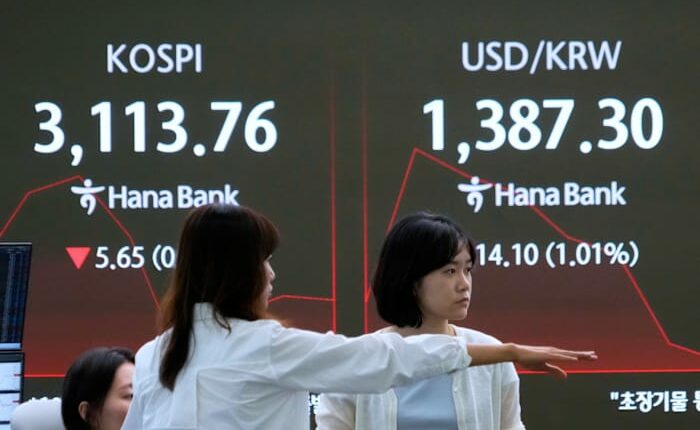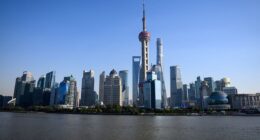Share this @internewscast.com

BANGKOK – Shares in Asia are mixed after Wall Street had its worst day since May following the release of weak U.S. jobs data.
Asian markets had already responded on Friday to U.S. President Donald Trump’s announcement of extensive tariffs on imports from several U.S. trading allies, leading to moderate losses. These new tariffs are scheduled to be implemented on Thursday.
Tokyo’s Nikkei 225 index lost 1.6%, bouncing back from bigger losses, to 40,134.97.
The Hang Seng in Hong Kong edged 0.2% higher, to 24,589.21, while the Shanghai Composite index was nearly unchanged at 3,562.18.
In South Korea, the Kospi surged 0.7% to 3,140.92.
Australia’s S&P/ASX 200 shed 0.2% to 8,643.00.
Investors’ concerns over a faltering U.S. economy heightened following the latest report on job growth showing that U.S. employers added only 73,000 jobs in July, significantly below economist expectations. Additionally, the Labor Department disclosed revisions that removed an astonishing 258,000 jobs from May and June payrolls.
Stephen Innes of SPI Asset Management commented that “The labor market, once a solid pillar of strength, now appears to be a late-cycle casualty as discussions shift from soft landings to more concerning scenarios.”
U.S. futures edged 0.3% higher, however, early Monday.
Last Friday, the S&P 500 dropped by 1.6%, marking its largest fall since May 21 and its fourth consecutive day of losses, closing at 6,238.01 with a 2.4% decrease for the week.
The Dow Jones Industrial Average fell 1.2% to 43,588.58, while the Nasdaq composite fell 2.2% to finish at 20,650.13.
Amazon, a giant in internet retail, fell by 8.3%, even though it reported positive profits and sales in its latest quarter. Meanwhile, tech giant Apple dipped 2.5% despite exceeding Wall Street’s profit and revenue estimates. Both companies are experiencing tougher conditions due to tariffs, with Apple predicting a $1.1 billion impact from the fees this quarter.
Trump’s directive to immediately dismiss the head of the government entity responsible for producing monthly job statistics has caused concern regarding potential interference in future data.
The surprisingly weak hiring numbers led investors to step up their expectations the Federal Reserve may cut interest rates in September.
The yield on the 10-year Treasury fell to 4.21% from 4.39% just before the hiring report was released. That’s a big move for the bond market. The yield on the two-year Treasury, which more closely tracks expectations for Fed actions, plunged to 3.68% from 3.94% just prior to the report’s release.
The Fed has held rates steady since December. A cut in rates would give the job market and overall economy a boost, but it could also risk fueling inflation, which is hovering stubbornly above the central bank’s 2% target.
An update on Thursday for the Fed’s preferred measure of inflation showed that prices ticked higher in June, rising to 2.6% from 2.4% in May.
The Fed held rates steady again at its most recent meeting this week. Fed Chair Jerome Powell has been pressured by Trump to cut the benchmark rate, though that decision isn’t his to make alone, but belongs to the 12 members of the Federal Open Market Committee.
Businesses, investors and the Fed have been operating under a cloud of uncertainty from Trump’s tariff policy.
Companies have been warning investors that unpredictable policies, with some tariffs already in effect while others change or get extended, make it difficult to plan ahead. Walmart, Procter & Gamble and many others also have warned about import taxes raising costs, eating into profits and raising prices for consumers.
In other dealings early Monday, U.S, benchmark crude oil lost 18 cents to $67.15 per barrel. Brent crude, the international standard, fell 23 cents to $69.44 per barrel.
The U.S. dollar rose to 147.80 Japanese yen from 147.26 yen. The euro weakened to $1.1577 from $1.1598.
Copyright 2025 The Associated Press. All rights reserved. This material may not be published, broadcast, rewritten or redistributed without permission.












